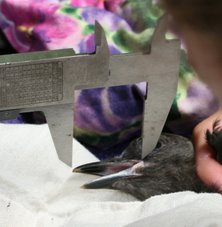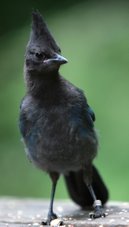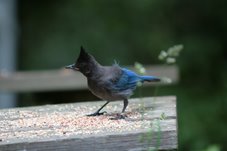NOTES
Wednesday, July 4, 2007
07:30
High fog, white sky, warm still
Birds Sighted In Order of Arrival:
1. mrgo
2. plbmp (rattles)
3. unbanded adult
4. banded juvenile
5. morlb (red right eye)
6. mwlblb
7. mlbrg
8. mlbob (rattles)
9. mwbw
10. mbow
11. pbmr (no tail bars?)
12. unbanded chases mwlblb
13. mlbbg?
Other birds sighted:
1. chestnut backed chickadee
2. varied thrush
Comments:
I’m spending a little time each day sitting on the deck with the jays eating peanuts. I notice which birds are willing to come close to me to get a peanut and which pause, roosted above, quiet, alert, waiting for me to move farther away. This is the time I will often hear soft chatty vocalizations. They are my very favorite—because of the variety of sounds and gentleness of tones. They are rich, expressive, and beg to be translated. Could they be subtle warnings that someone is near, or casual approaches to biding time until the coast is clear to feed without intruders? The temptation to anthropomorphize is irresistible and I am aware of a merging jaynesss with humanness-- for the moment, our commonalities more distinct than our differences.
Mwlblb is by far the tamest bird. He may hesitate slightly before approaching me, but then hops, boldly to take a peanut. This is always disconcerting for mrgo, who claims this feeder, but doesn’t have the courage to take charge when I am too near. Today, morlb (red eye) appears more culturally assimilated, taking time to select, eat a peanut now and then, perch, and survey, before caching; however, there are still times when he reverts and becomes unexpectedly skittish, dashing off. He too, is a very tame bird and does not shy away from me.
High fog, white sky, warm still
Birds Sighted In Order of Arrival:
1. mrgo
2. plbmp (rattles)
3. unbanded adult
4. banded juvenile
5. morlb (red right eye)
6. mwlblb
7. mlbrg
8. mlbob (rattles)
9. mwbw
10. mbow
11. pbmr (no tail bars?)
12. unbanded chases mwlblb
13. mlbbg?
Other birds sighted:
1. chestnut backed chickadee
2. varied thrush
Comments:
I’m spending a little time each day sitting on the deck with the jays eating peanuts. I notice which birds are willing to come close to me to get a peanut and which pause, roosted above, quiet, alert, waiting for me to move farther away. This is the time I will often hear soft chatty vocalizations. They are my very favorite—because of the variety of sounds and gentleness of tones. They are rich, expressive, and beg to be translated. Could they be subtle warnings that someone is near, or casual approaches to biding time until the coast is clear to feed without intruders? The temptation to anthropomorphize is irresistible and I am aware of a merging jaynesss with humanness-- for the moment, our commonalities more distinct than our differences.
Mwlblb is by far the tamest bird. He may hesitate slightly before approaching me, but then hops, boldly to take a peanut. This is always disconcerting for mrgo, who claims this feeder, but doesn’t have the courage to take charge when I am too near. Today, morlb (red eye) appears more culturally assimilated, taking time to select, eat a peanut now and then, perch, and survey, before caching; however, there are still times when he reverts and becomes unexpectedly skittish, dashing off. He too, is a very tame bird and does not shy away from me.
Subscribe to:
Post Comments (Atom)
Pia Sets the Trap

07/24/07
Peaking...

07/24/07
Oops, wrong bird!

Demonstrating the "hold"
Try Again

Bird in the Bag

Applying a metal band
Measuring

and more measuring. . . .

Blood Sampling

Jeff J's Work

Pia's test tube holder
Weighing

And then....release
When the sun goes down...

Steller's Jay Taxonomy/Description
Common Name: Steller's Jay
Class: Aves
Order: Passeriformes
Family: Corvidae
Genus: Cyanocitta
Species: Cyanocitta stelleri
Steller’s jay belongs to the family, Corvidae, in the Avian Order Passeriformes. Passeriformes is the order of perching birds. Corvidae is the jay, magpie and crow family. The Steller's jay's scientific name is Cyanocitta stelleri. The generic name, cyanocitta, means "blue jay". Its specific name, stelleri, named for George W. Steller (1709-1746). Steller was a German zoologist who explored the coastal areas of the northern Pacific Ocean in 1740.
Band Colors
black | white | purple | red | orangeBands are read in the following order:
light blue and light blue | green
Note: Light blue is difficult to read. It darkens with age, resembling a green band. (b/w/p/r/o/lb/g)
right bottom band
right top band
left bottom band
left top band
Data Collecting
This information was copied from the website of Dr. Jeff Black, Humboldt State University Wildlife Department.
The data to include for each record:
- Bird’s color code
- Size of social group seen at the same time
- Associates’ color codes (or if unbanded = UNB; or not determined = NOTD)
- Number of times associates came within 3 meters of each other
- Approximate time spent within 3 meter distance (e.g. 2 seconds, 15 sec, etc.)
- Total time you watched the birds (e.g. 5 minutes, 10 min, etc.)
- Time of day; start of observation (e.g. 1935)
- Date (e.g. 9.30.99)
- Location of observation (e.g. Rewood Bowl SW corner west bleachers. And state whether the bird was seen at a birdfeeder or in trees, etc)
- Comments (e.g. deformed leg, feather tuft on back, etc.)
Arcata Steller's Jay Sightings
Mr. Go

































No comments:
Post a Comment